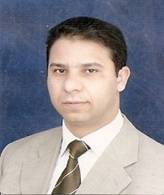
Prof. Mohamed Eddouks
Dean, Polydisciplinary Faculty of Errachidia
Moulay Ismail University, Morocco
Professor of Physiology/Pharmacology
Email: Mohamed.eddouks@laposte.net

Qualifications
1997 Ph.D., University of Sidi Mohammed Ben Abdellah, Fez
1994 Postdoctoral, University of Montreal, Montreal
1993 Ph.D., University of Liège, Belgium
1990 M.Sc., University Paris 6, France
RESEARCH EXPERIENCE
Publications (Selected)
- Eddouks M, Chattopadhyay D, Zeggwagh NA.Animal models as tools to investigate antidiabetic and anti-inflammatory plants.Evid Based Complement Alternat Med. 2012;2012:142087.
- Zeggwagh NA, Michel JB, Eddouks M.Vascular Effects of Aqueous Extract of Chamaemelum nobile: In Vitro Pharmacological Studies in Rats.Clin Exp Hypertens. 2012.
- Oufni L, Taj S, Manaut B, Eddouks M. 2011.Transfer of uranium and thorium from soil to different parts of medicinal plants using SSNTD. Journal of Radioanalytical and Nuclear Chemistry, 287; 403-411.
- Zeggwagh NA, Moufid A, Michel JB, Eddouks M. Hypotensive effect of Chamaemelum nobile aqueous extract in spontaneously hypertensive rats.Clin Exp Hypertens. 2009.31(5):440-50.
- Zeggwagh NA, Farid O, Michel JB, Eddouks M. Cardiovascular effect of Artemisia herba alba aqueous extract in spontaneously hypertensive rats.Methods Find Exp Clin Pharmacol. 2008. 30(5):375-81.
- Eddouks M, Maghrani M, Louedec L, Haloui M, Michel JB.Antihypertensive activity of the aqueous extract of Retama raetam Forssk. leaves in spontaneously hypertensive rats.J Herb Pharmacother. 2007;7(2):65-77.
- Zeggwagh, N-A., Eddouks, M . Anti-hyperglycaemic and hypolipidemic effects of Ocimum basilicum aqueous extract in diabetic rats. American Journal of Pharmacology and Toxicology. 2(3): 123-129, 2007.
- Lemhadri, A., Burcelin, R., Eddouks, M. Chamaemelum nobile L. aqueous extract represses endogenous glucose production and improves insulin sensitivity in streptozotocin-induced diabetic mice. American Journal of Pharmacology and Toxicology. 2(3): 116-122, 2007.
- Lemhadri, A., Eddouks, M., Burcelin, R. Anti-hyperglycaemic and anti-obesity effects of Capparis spinosa and Chamaemelum nobile aqueous extracts in HFD mice. American Journal of Pharmacology and Toxicology. 2(3): 106-110, 2007.
- Zeggwagh, N.A., Michel, J.B, and Eddouks, M. Acute Hypotensive and Diuretic Activities of Chamaemelum nobile Aqueous Extract in Normal Rats. American Journal of Pharmacology and Toxicology. 2(3): 140-145, 2007.
- Zeggwagh, N-A., Michel, JB., Eddouks, M . Cardiovascular effect of Capapris spinosa aqueous extract in rats Part II: Furosemide-like effect of Capparis spinosa aqueous extract in normal rats. 2(3): 130-134, 2007.
- Zeggwagh, N-A., Michel, JB., Eddouks, M . Cardiovascular effect of Capparis spinosa aqueous extract. Part III: Antihypertensive effect in spontaneously hypertensive rats. American Journal of Pharmacology and Toxicology. 2(3): 111-115, 2007.
- Zeggwagh, N-A., Eddouks, M .Michel, JB. Cardiovascular effect of Capparis spinosa aqueous extract. Part VI: in vitro vasorelaxant effect.American Journal of Pharmacology and Toxicology. 2(3): 135-139, 2007.
- Eddouks, M., Ouahidi, M.L., Farid, O., Moufid, A., Lemhadri, A. The use of medicinal plants in the treatment of diabetes in Morocco. Phytothérapie. 2007, 5, no4, pp.194-203.
- Eddouks M; Khalidi A; Zeggwagh N.-A; Pharmacological approach of plants traditionally used in treating hypertension in Morocco. Phytothérapie. 2009, 7, no2, pp. 122-127.
- Zeggwagh NA, Ouahidi ML, Lemhadri A, Eddouks M. 2006. Study of hypoglycaemic and hypolipidemic effects of Inula viscosa L. aqueous extract in normal and diabetic rats. Journal ofEthnopharmacology. 24; 108(2): 223-7.
- Lemhadri A, Hajji L, Michel JB, Eddouks M. Cholesterol and triglycerides lowering activities of caraway fruits in normal and streptozotocin diabetic rats. Journal ofEthnopharmacology 2006 19; 106(3):321-6.
- Eddouks, M., Maghrani, M, Michel, J-B.Antihypertensive action of Lepidium sativum in SHR rats. In Press. Journal of Herbal Pharmacotherapy.Eddouks, M., Michel, J-B., Mghrani, M. Effect of Lepidium sativum L. On renal glucose reabsorption and urinary TGF B levels in diabetic rats. Phytotherapy Research. 2008 ;22(1):1-5.
- Eddouks M, Maghrani M, Michel JB.2005.Hypoglycaemic effect of Triticum repens P. Beauv. in normal and diabetic rats. Journal of Ethnopharmacology. 2005 ; 102(2):228-32.
- Eddouks, M. 2005. Les plantes anti-diabétiques. Phytothérapie Européenne. 28, 8-12.
- Zhang J, Onakpoya IJ, Posadzki P, Eddouks M. The safety of herbal medicine: from prejudice to evidence. Evid Based Complement Alternat Med. 2015;2015:316706.
- Yakubu MT, Sunmonu TO, Lewu FB, Ashafa AO, Olorunniji FJ, Eddouks M. Efficacy and safety of medicinal plants used in the management of diabetes mellitus. Evid Based Complement Alternat Med. 2014; 2014: 793035.
- Eddouks M, Chattopadhyay D, De Feo V, Cho WC. Medicinal plants in the prevention and treatment of chronic diseases 2013. Evid Based Complement Alternat Med. 2014;2014:180981.
- Eddouks M, Bidi A, El Bouhali B, Hajji L, Zeggwagh NA. Antidiabetic plants improving insulin sensitivity. J Pharm Pharmacol. 2014 Sep;66(9):1197-214.
Efficacy and Safety of Olive in the Management of Hyperglycemia

Eddouks M*
Faculty of Sciences and Techniques Errachidia, Moulay Ismail university, BP 21, Errachidia, 52000, Morocco
MOHAMED EDDOUKS
Professor
Faculty of Sciences and Techniques Errachidia
Moulay Ismail University
Morocco
Faculty of Sciences and Techniques Errachidia
Moulay Ismail University
Morocco
Dr. Mohamed Eddouks is currently working as a professor at Moulay ismail university, morocco. He worked as assistant professor at faculty of sciences and techniques errachidia (1995) and as head of the department of biology at faculty of sciences and techniques errachidia (2003). He completed his PhD degree in Physiology and Pharmacology from University of Liege, Belgium and Sidi Mohammed Ben Abdellah University. He published many articles in international journals.
Eddouks M
Faculty of Sciences and Techniques Errachidia
Moulay Ismail university, BP 21
Errachidia, 52000, Morocco
Tel: +212535574497
Fax: +212535574485
E-mail: mohamed.eddouks@laposte.net
Faculty of Sciences and Techniques Errachidia
Moulay Ismail university, BP 21
Errachidia, 52000, Morocco
Tel: +212535574497
Fax: +212535574485
E-mail: mohamed.eddouks@laposte.net
Citation: Eddouks M (2015) Efficacy and Safety of Olive in the Management of Hyperglycemia. Pharmaceut Reg Affairs 4:e145. doi:10.4172/2167-7689.1000e145

Postprandial hyperglycemia indicates the abnormality in glucose turnover leading to the onset of type 2 diabetes. Therefore, correction of postprandial hyperglycemia is crucial in the early stage of diabetes therapy. One of the most effective strategies to control postprandial hyperglycemia is medication combined with intake restriction and an exercise program. However, along with the prevalence of chronic diseases with multi-pathogenic factor, drugs with single chemical composition are usually not effective. In this view, phytotherapy has a promising future in the management of diabetes, considered to have less side effects as compared to synthetic drugs.
The World Health Organization estimates that in developing countries about 80% of the population now still depend on herbal treatment. Olive (Olea europea) (OE) has been used in traditional remedies in Europe and Mediterranean countries as a food and medicine for over 5,000 years especially for the prevention and treatment of chronic diseases such as hypertension, atherosclerosis , cancer and diabetes. In addition, olive is considered as the most important component of the Mediterranean diet with many health benefits.
Several experimental studies have demonstrated the beneficial effect of OE on diabetes. This effect has been demonstrated in the animal models such as streptozotocin-induced diabetic rats, alloxaninduced diabetic rats and obese diabetic sand rats fed a hypercaloric diet. In these models olive extracts have been shown to exhibit a significant reduction on both blood glucose and insulin levels. Few randomized clinical trials have demonstrated the beneficial effect of olive and one study has shown that the subjects treated with olive leaf extract exhibited significantly lower Glycated hemoglobin (HbA1c) and fasting plasma insulin levels.
Another study performed in recent onset type 2 diabetic patients has revealed that OE leaves exhibited antidiabetic activity when it added as a mixture of extract of leaves of Juglans regia, Urtica dioica and Atriplex halimus. The underlying mechanism seems to be the improvement of glucose uptake and no side effect was reported while extracts from OE have been found to exhibit cytotoxic effects only at concentrations higher than 500 μg/ mL in cells from the liver hepatocellular carcinoma cell line (HepG2) and cells from the rat L6 muscle cell line. As far as the phytochemical analysis is concerned, it is now well-established that major fatty acid constituents and minor phenolic components in olives and olive oil exert important health benefits particularly for cardiovascular diseases, metabolic syndrome and inflammatory conditions.
Hydroxytyrosol and oleuropein are considered as major polyphenolic compounds in olive leaf. Oleuropeoside, a phenylethanoid isolated from OE demonstrated a significant hypoglycemic activity in alloxan-induced diabetes and the hypoglycemic activity of this compound may result from both the increased peripheral uptake of glucose and potentiation of glucose-induced insulin secretion. In addition, Maslinic acid (MA), a natural triterpene from OE with hypoglycemic activity is a wellknown inhibitor of glycogen phosphorylase in diabetic rats without affecting hematological, histopathologic and biochemical variables, thus suggesting a sufficient margin of safety for its putative use as a nutraceutical. More recently a study has showed that MA exerts antidiabetic effects by increasing glycogen content and inhibiting glycogen phosphorylase activity in HepG2 cells.

Furthermore, MA was shown to induce the phosphorylation level of insulin-receptor β-subunit, protein kinase B (Akt) and glycogen synthase kinase-3β. MA treatment of mice fed with a high-fat diet reduced the model-associated adiposity, mRNA expression of proinflammatory cytokines and then insulin resistance, and increased the accumulated hepatic glycogen.
Finally, a recent clinical study has revealed that supplementation with olive leaf polyphenols significantly improved insulin sensitivity and pancreatic β-cell secretory capacity in overweight middle-aged men at risk of developing the metabolic syndrome. In conclusion, OE has been and continue to represent a natural source of phytocompounds eliciting a beneficial effect in human health especially in the management of hyperglycemia [1-15].
- Bennani-Kabchi N Fdhil H,Cherrah Y,El Bouayadi F,Kehel L,et al.(2000) Therapeutic effect ofOleaeuropeavar. oleaster leaves on carbohydrate and lipid metabolism in obese and prediabetic sand rats (Psammomysobesus).Ann Pharm Fr 58: 271-7.
- Said O,Fulder S, Khalil K,Azaizeh H, Kassis E, et al. (2008) Maintaining a physiological blood glucose level with 'glucolevel', a combination of four anti-diabetesplants used in the traditional arab herbal medicine. Evid Based Complement Alternat Med 5:421-8.
- Bouallagui Z,Han J,Isoda H,Sayadi S. Hydroxytyrosol rich extract from olive leaves modulates cell cycle progression in MCF-7 human breast cancer cells (2011) Food ChemToxicol 49:179-84.
- Nan JN,Ververis K ,Bollu S,Rodd AL,Swarup O,et al. (2014) Biological effects of the olive polyphenol, hydroxytyrosol: An extra view from genome-wide transcriptome analysis.Hell J Nucl Med 17: 62-9.
- Guan T, Qian Y, Tang X, Huang M, Huang L, et al. (2011) Maslinic acid, a natural inhibitor of glycogen phosphorylase, reduces cerebral ischemic injury in hyperglycemic rats by GLT-1 up-regulation. Neurosci Res 89: 1829-39.
- Sánchez-González M, Lozano-Mena G, Juan ME, García-Granados A, Planas JM (2013)Assessment of thesafetyof maslinic acid, a bioactive compound from Oleaeuropaea L.Mol Nutr Food Res 57:339-46.
- Liu J, Wang X, Chen YP, Mao LF, Shang J, et al. (2014) Maslinic acidmodulates glycogen metabolism by enhancing the insulin signaling pathway and inhibiting glycogen phosphorylase.Chin J Nat Med 12: 259-65.
- de Bock M, Derraik JG, Brennan CM, Biggs JB, Morgan PE,(2013) Olive(Oleaeuropaea L.) leaf polyphenols improve insulin sensitivity in middle-aged overweight men: a randomized, placebo-controlled, crossover trial.





Er Rachidi; Errachidia



...........
Morocco


////////



























.svg/2000px-Delaware_in_United_States_(US48).svg.png)

